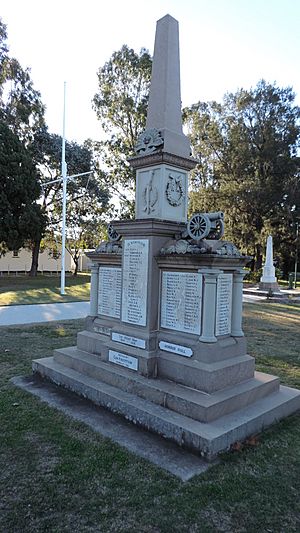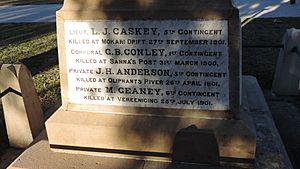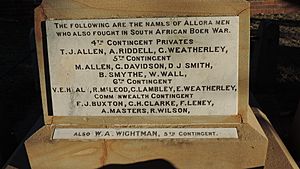Boer War Memorial, Allora facts for kids
Quick facts for kids Boer War Memorial, Allora |
|
|---|---|

Boer War Memorial, Allora, 2015
|
|
| Location | Warwick Street, Allora, Southern Downs Region, Queensland, Australia |
| Design period | 1900–1914 (early 20th century) |
| Built | 1904 – 1940s |
| Official name: Boer War Memorial and Park, Queen's Park, War Memorial Park | |
| Type | state heritage (built) |
| Designated | 21 October 1992 |
| Reference no. | 600005 |
| Significant period | 1904 – |
| Significant components | memorial – soldier statue, memorial surrounds/railings, park / green space, memorial – obelisk, fencing, fence/wall – perimeter |
| Lua error in Module:Location_map at line 420: attempt to index field 'wikibase' (a nil value). | |
The Boer War Memorial in Allora, Queensland, is a special monument built to remember Australian soldiers. It's located on Warwick Street in a park that also has memorials for World War I and World War II. This memorial was built a long time ago, starting in 1904, and is recognized as an important part of Queensland's history.
Contents
The Story Behind the Memorial
The War Memorial Park in Allora holds several important memorials. The first one, for the Second Boer War, was revealed in 1904. Later, memorials for World War I (1921) and World War II were added. There are also tributes to more recent conflicts Australia has been involved in.
The land for this park was set aside for public use way back in 1879. In 1902, it was officially named a park for recreation.
Remembering the Boer War
The Boer War lasted from 1899 to 1902. It was a conflict in South Africa where Australian soldiers fought. After this war, only three memorials in Queensland featured a soldier statue. The Allora memorial was the first planned in 1904. Later ones were built in Gatton (1908) and Brisbane (1919).
Many other types of memorials were also built. These included avenues of trees, bells, plaques, and tall stone pillars called obelisks. Building war memorials became more common after the Boer War. Queensland lost 67 soldiers in that conflict. After World War I, building these monuments became even more important. It showed a growing sense of Australian national pride.
The Unveiling Ceremony
The Allora Boer War Memorial was officially revealed on August 19, 1904. This day was a public holiday in the area. Colonel (who later became General Sir) Harry Chauvel led the ceremony. Chauvel was a very respected Queensland soldier. He believed in honoring soldiers who gave their lives for their country. He even helped set up the first Australian War Memorial on a battlefield in South Africa.
Chauvel noted that the Allora memorial was one of the very few built in Queensland at that time for the Boer War.
Who Built It?
The base of the Boer Memorial was built by Mr. J. McCulloch from Warwick. The design came from WP Prout. The memorial cost about £134, which was a lot of money back then! A special committee raised the funds. The sandstone used came from Mr. Midson's quarry near Warwick.
The soldier statue itself was created by William Priestly MacIntosh. He was a famous sculptor who came to Australia in 1880. He worked on many important buildings in Sydney and Brisbane. His work on the Allora Boer Memorial was done shortly after he arrived in Brisbane in 1903.
Developing the Park
After the Boer War Memorial was finished, the committee wanted to make the area a proper park. They got 120 trees donated from the Botanical Gardens in Brisbane. The Mayor of Allora also gave trees, which were planted along Raff Street. We don't know if any of these original trees are still there today.
In 1921, another memorial was added to the park. This one was for World War I. It was built as a tall, pointed pillar (an obelisk) and was designed by WJ Prout. General JC Robertson unveiled this memorial in November 1921.
Later, a third memorial was built for soldiers who died in World War II. This one is also an obelisk, made with a sandstone base and a marble shaft.
What the Memorials Look Like
The Boer War Memorial is in a small park in Allora, facing Warwick Street. The park has a strong brick and wrought iron fence along Warwick Street. There's a main gate in the middle with an iron gate. The Boer War and First World War memorials are closer to Warwick Street. The Second World War Memorial is further back in the park.
The Boer War Memorial
The Boer Memorial stands about 15 feet tall. It has a base, a pedestal (a strong support), and a soldier statue on top. A low fence with posts and steel rods surrounds the memorial.
The memorial is made of sandstone. It has steps at the bottom and smooth stone sections. On these sections are marble plaques. These plaques tell about the memorial's opening and list the names of Allora men who fought in the war. They also list those who died.
The pedestal has a special design with carved leaves and columns at its corners. These columns support a decorative top section.
The soldier statue on top is a bit smaller than life-size. The soldier stands at attention, with his head bowed and his rifle held in reverse. What's unusual is that his mouth is open, and he stands alone without a tree stump for support, which was common for these statues. The sculptor's name, WP MACINTOSH, is carved on the base of the statue.
Other Memorials in the Park
The World War One Memorial is mostly made of sandstone and marble. It has a three-part base with a tall obelisk (pillar) on top. It also has columns at its corners and small carved field guns on the sides. The obelisk itself is a smooth, tapering column with carved shields on its north and south sides.
The World War Two Memorial is at the back of the park. It's a simpler obelisk. It has a sandstone base with white marble steps. On top sits a tall, tapering column of white marble. A wreath and a gun are carved on its south side.
Why This Place is Important
The Boer War Memorial and Park was added to the Queensland Heritage Register on October 21, 1992. This means it's recognized as a very important historical site.
- A Look into Queensland's Past: This memorial helps us understand how Queensland's history unfolded. It was one of the first "digger" statues built to remember soldiers from the Boer War. At that time (1904), war memorials were quite rare in the state.
- Unique and Special: The soldier statue is special because of its design and details. It's one of the few known memorials sculpted by the famous Sydney artist WP Macintosh.
- Showing What War Memorials Are Like: The three memorials in the park (Boer War, WWI, WWII) are great examples of war memorials in Queensland. They use symbols that are common for such monuments.
- Beautiful to Look At: The Boer War and World War I Memorials are beautiful on their own. They also look good together because they share similar designs and decorations.
- Important to the Community: The Memorial Park is very important to the local community. It helps them remember and honor the people from their area who served in major wars.
- Connected to Important People: These memorials are linked to important figures in Queensland's history. This includes Sir Harry Chauvel, who unveiled the Boer War Memorial, and William Macintosh, who sculpted the soldier statue. It also honors all the brave soldiers whose names are on the memorials.






